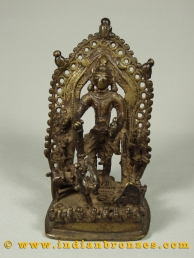Folk Art Bhairava/Shiva (IBS290)
Description
Normally folk art bronzes are fairly small and this is one of the largest we have seen. Folk art is becoming extremely collectable and genuine pieces are harder to come by.
Here we have an image of Shiva in typical folk art style. He stands flanked by two attendants, one offering Him a plate of food, the other holding a sword and bowl. The staff He is holding is being licked by Nandi, who is also accompanies by a calf. In front of Shiva is a horse and rider. The rider is holding a sword which illustrates Shiva's warrior status. There are representation of Shiva's consort, Parvati and their son Ganesha in the front right corner.
All around the front of the base are 8+2 heads representing the Guardians of the Directions. These are the deities who rule the specific directions of space according to Hinduism and Vajrayāna Buddhism—especially Kālacakra. As a group of eight deities, they are called Asta-Dikpāla (literally guardians of 8 directions). They are often augmented with two extra deities for the ten directions (the two extra directions being zenith and nadir), when they are known as the Daśa-Dikpāla. In Hinduism it is traditional to represent their images on the walls and ceilings of Hindu temples.
In this image Shiva is holding the conch which is normally associated with Vishnu. According to tradition Lord Shiva once stole Vishnu's conch, but blew the conch so loudly that Vishnu knew immediately who had it. Shiva instantly appeared before Vishnu and explained that the conch was at his home on Mt. Kailash, but it was his son the elephant god Ganesh who had it. If Vishnu wanted the conch returned he would first have to perform a puja ceremony in honour of Ganesh. The Hindu gods are always engaged in these mythic dramas, usually for our benefit. It is not uncommon to hear the chant, "Bom Shiva Shankara!" which means "Hail Lord Shiva the Conch Shell Blower!" A conch (shankha) is blown to invoke Shiva, this is not so in the case of other Hindu deities. The conch is a rather primitive instrument used in tribal societies. There is a special relation between the conch (shankha) and Shiva as is evident from the similarity between the word Shankha and the word Shankara which is one of Shiva's many names. The word Shankara could have been derived from Shankha-kara which roughly means conch-blower (Shankha = conch, Kara = blower).
On the floor are various offerings. To the left and right of Shiva's head are symbols of the sun and the moon.
The piece is in very fine condition with just a small amount of bronze loss at the back of the base top.
Folk pieces of this size, age and complexity are very rare and this represents a superb example.







